#mimic thrush
Explore tagged Tumblr posts
Text

Long-billed Thrasher (Toxostoma longirostre), family Mimidae, order Passeriformes, Laguna Seca Ranch, South TX, USA
photograph by Karen Schneider
#thrasher#toxostoma#mimidae#mimic thrush#bird#ornithology#animals#nature#north america#passeriformes
365 notes
·
View notes
Text
10 key moments/themes of my wildlife watching and photos over the last week
Mistle Thrushes at Whitefield Moor in the New Forest
On a lovely walk there last Sunday it was nice to see a fair few of this charming bird.

A view over the type of area they were on the walk.
Jersey Tiger moth at Lakeside
Stunning moments Monday lunch time and evening at the entrance to Lakeside where I was entranced by a prominent and beautiful Jersey Tiger moth on a leaf. One of my best moth moments of the year.

The Jersey Tiger moth
Watching a patch of fleabane full of Gatekeepers and turning round to find a Wasp Spider in the grass at Lakeside
On Tuesday the wealth of Gatekeepers and other butterflies observed on my lunch time walk was a great way to start to sign off in the last week of the Big Butterfly Count in a week I saw pleasingly loads and a variety of butterflies following one of my big butterfly days of the year last Saturday, and the Wasp Spider was one of the most exciting wild moments of my year and one I had hoped for over the last couple of years.
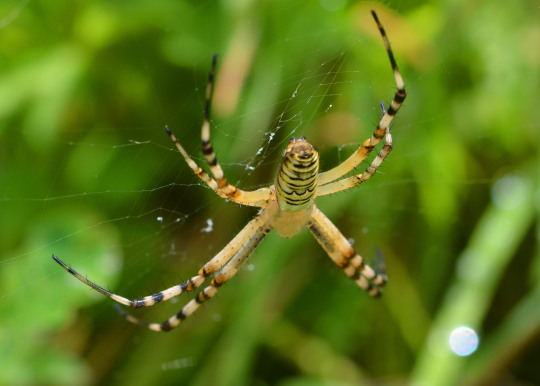
The Wasp Spider
Seeing Pied and Spotted Flycatcher at Millyford Bridge in the New Forest
A pivotal moment in my birdwatching year yesterday, being stunned to see not only the charming Spotted Flycatchers but my first gorgeous Pied Flycatcher of the year, a stunning bird. Blissful time spent in the forest.

A record shot of the Pied Flycatcher
Hornet mimic hoverflies at Winnall Moors and Lakeside
Another insect I had hoped to see, I always seem to see something special when I'm drawn to Winnall Moors on an office working day lunch break and this was it on Thursday. Then I enjoyed seeing this prepossessing hoverfly again at Lakeside on Friday evening.

Hornet mimic hoverfly at Winnall Moors
Common Terns at Lakeside
On both Monday and Friday I was overjoyed to observe this infrequent Lakeside visitor, alongside the ever present Lesser Black-backed Gull chick and adults around here of late bringing a slice of the coast to the country park with their evocative shriek and it was a delight to watch these acrobats circle in the air and dive to fish. A real treat.

One of the pair of adult Common Terns at Lakeside on Friday.
Cormorant among the Great Crested Grebes at Lakeside
Also on Tuesday adding to what was really a crazy working week for unexpected sightings on Lakeside walks was another infrequent visitor to Lakeside especially in summer months, a pretty Cormorant. It was so nice to see it and quite surreal seeing it swim alongside the young Great Crested Grebes, I enjoyed intimate moments with them this week.

Cormorant at Lakeside
A taste of late summer into autumn
It was a nice week of contrast particularly in my plant and fungi year with one of the last flowers I'll see in bloom perhaps this year locally chicory which I liked seeing on Monday, contrasting fruit increasing with guelder rose berries, blackberries, my first hawthorn berries of the year and approaching rose hips locally. Albeit helped by the wet weather, at home and at Millyford Bridge in the New Forest yesterday a big presence of mushrooms threw me forward to autumnal times. And on the two New Forest walks it was great to observe different types of heather coming out as the landscape just puts an arm inside its late summer jacket of purple.

Whitefield Moor in the New Forest
Dragonflies at Lakeside: Seeing my first Migrant Hawker of the year and a beautiful female Common Darter
There is still much to see in my dragonfly year and also on Monday's packed lunch time walk I got my first glimpse of a Migrant Hawker this year. Another key Lakeside species gave me a strong and precious moment on Friday's evening walk with an enchanting Common Darter seen flying and landed on dock.
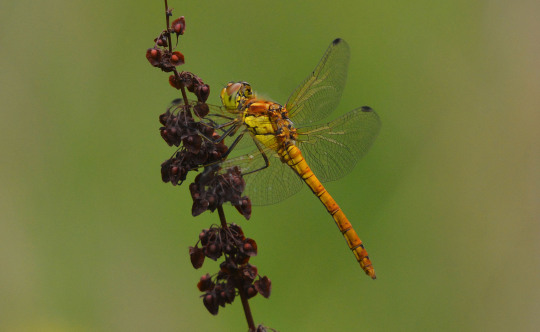
A variety of wildlife enjoyed at home
Finally from seeing and hearing Lesser Black-backed Gulls and Greylag Geese from home to seeing young Goldfinches a lot and a young House Sparrow being fed on the balcony feeders I've had a great week of birds at home. A Blue Tit seen a few times, lots of Starlings and an exciting moment seeing a male Sparrowhawk on next door's gate this morning were other lovely moments. As was seeing some Small White butterflies out the front, spiders, a snail out the front and Udea fulvalis and plume moths.
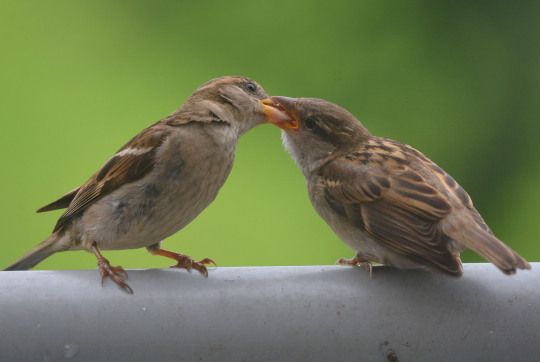
House Sparrow and young yesterday
#photography#wasp spider#common tern#cormorant#gatekeeper#hornet mimic hoverfly#small white#jersey tiger moth#common darter#pied flycatcher#mistle thrush#spotted flycatcher#july#august#summer#new forest#millyford bridge#whitefield moor#europe#england#2023
4 notes
·
View notes
Note
Somehow I have missed the prior rounds of state bird chatter, but I don't think you've said yet what your pick would be for Ohio? I know we're a cornfields state from the highway, but beween the Great Lakes, Appalachia, and the residual eastern woodlands pockets IDK what's properly universal. I'm a huge fan of red-shouldered hawks and great horned owls, but admittedly I'm biased towards raptors and I don't think looking at range maps that either is particularly state-specific.
Ahh yes, Ohio is right smack in the middle of the “Cardinal Belt”. An extremely uninspired choice for the state especially considering that they selected the cardinal as state bird in 1933, a full seven years after Kentucky had already called first dibs! Still not as embarrassing as Virginia who took the cardinal dead last in 1950.
Cardinals are great but having that many duplicates all clustered together is a wasted opportunity. I agree we can do better for Ohio!
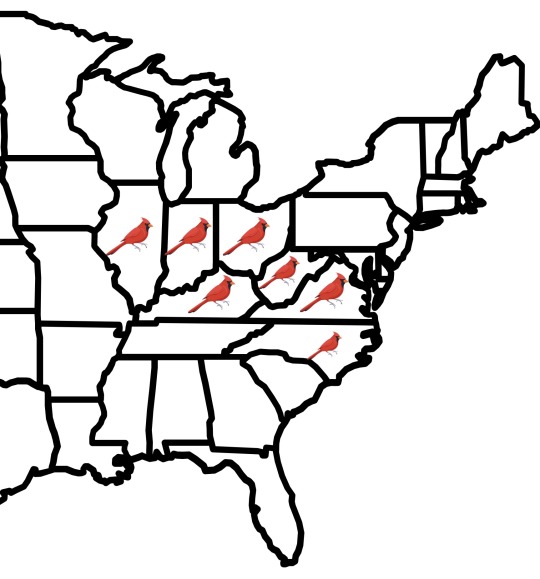
As a fellow raptor enthusiast I share your bias and fully support both the Redtail and Great horned owl as choices. It’s shocking the effortlessly charismatic red-tailed hawk is still up for grabs! I have actually always liked the idea of an owl for Ohio just for the “O” theme. I’ve considered the barred owl; A native bird of prey that will be quite familiar and recognizable to many Ohioans. Ohio was a key state for the Underground Railroad, and Harriet Tubman herself worked and traveled through the state a great deal. When giving signals to escaping slaves, Tubman would mimic with great accuracy the iconic call of a barred owl.
Other possible alternates might include the Wood thrush, a sweet-faced bird that breeds in large amounts in Ohio or the Ruby-throated Hummingbird. The latter is a primary pollinator of the state tree- the Buckeye! The little red patch on the male’s throat also kinda evokes the buckeye on the Ohio flag.

106 notes
·
View notes
Note
Do you know what the biggest lie ever told in one piece is?
"There are only 5 devil fruits that can fly"
I mean Pell sounded cool when he said it but it has gotten worse over time with every devil fruit that appears.
Let's go down the list from least to most ridiculous DF users who can fly.
ACTUAL BIRDS:
-Pell [Bird Bird fruit: Model Falcon]
-Marco [Bird Bird fruit: Model Phoenix]
-Morgans [Bird Bird fruit: Model Albatross ]*
*Morgans is flightless in his hybrid form, but Albatrosses can naturally fly for long distances*
-Buzz [Bird Bird fruit Model eagle]**
**Buzz is a noncanon character from the movie One piece strawhat chase. He is a dog**
OTHER FLYING ANIMALS:
-Cub [bug bug fruit: Model rhinoceros beetle]
-Bian [bug bug fruit: Model hornet]
While bugs are known for crawling, these two tontatas have DFs who's species can naturally fly.
-King [Dragon Dragon fruit: Model Pteranodon]
Flying is the only natural thing that King does with his fruit. All the fire stuff is unique to King
-Kaido/Momonosuke [DF NAME UNKNOWN]
Momo can fly by summoning clouds and walking on them but dragons appear to have the innate ability to fly as shown with Kaido
BIRD BY TECHNICALITY:
-Toragatsu [Bird Bird fruit Model: Nue]
Torgatsu is a noncanon character from the One Piece x Kyoto art show. The nue is a chimera like creature from Japanese folklore that has the body of a tiger, head of a monkey and a snake for a tail. Alternatively it can be described as having the back of a tiger, the limbs of a tanuki, the tail of a fox, the head of a cat, and the torso of a chicken. It is a bird fruit because the name Nue also refers to the scaly thrush bird that the chimera mimics. Torgatsu can fly by summoning rainbow colored flames.
LOGIAS:
All known logia users [with the exceptions of Aokiji, Akainu*, Blackbeard &Caribou ] can fly via elemental propulsion. [*Akainu is in a different category]
-Ace/Sabo [flame flame fruit]
-Smoker [plume plume fruit](smoke)
-Crocodile [Sand sand fruit]*
*the presence of these 3 fruits alone in alabasta immediately invalidated Pell's statement*
-Kizaru [glint glint fruit] (light)
-Enel [Rumble Rumble fruit] (Lightning)
-Caesar Clown [Gas Gas fruit]
-Monet [Snow snow fruit]
PARAMECIA SHENANIGANS
-Shiki [Float Float fruit]
man can just straight up fly
-Trafalgar Law [Op Op fruit]
-Fujitora [Press Press fruit]
-Eustass Kid [Magnet Magnet Fruit]
The above manipulate their environment to create platforms that they ride on.
-Big Mom [Soul soul fruit]
Can use her soul to create constructs that she rides on
-Perona [Hollow Hollow fruit]
Can fly by turning herself into a ghost.
-buffalo [Spin Spinf Fruit]
Can fly by helicoptering his body parts.
IS IT FLYING IF I DON'T TOUCH THE GROUND?
-Akainu [Mag mag fruit]
Has been shown to use his magma to propel himself short distances but hasn't shown the ability to fly
-Magellan [Venom Venom fruit]
Can create pathways of poison that allow him to fast travel around impel down
FLIGHT BY TECHNICALITY
-Buggy [Chop chopper fruit]
his body parts can Float around within a certain radius of him, excluding his feet.
DOESNT COUNT AS FLYING
-Ms. Valentine [Kilo Kilo fruit]
Reducing her weight to 1Kg allows her to jump really high into the air and slowly fall down
??????
Karasu [DF UNKNOWN]
Can turn himself into a murder of crows and fly.
SHOULD NOT BE ABLE TO FLY AT ALL
-Doflamingo[string string fruit]
He flies by spidermaning his way through the air, sticking his strings to clouds
-Robin [flower flower fruit]
Grows several dozen arms that she fuses into a pair of wings
-Luffy [Gum Gum fruit]
Gear 4. Contracts and expands his legs with so much speed and force that it generates thrust.
There are probably some others that I missed but these are the major ones for where you are.
This a really cool categorization and also
Perhaps it was meant that only 5 DF like actually come with wings and the other ones just elevate their powers to do all that crazy shit
Or perhaps is further evidence Oda makes it all up as he goes along (most likely lol)
43 notes
·
View notes
Text
It's been so long since I last posted about a Mimic fic.
First Flights
Word Count: 3360 Rating: G Ship: Reimu Hakurei/Hieda no Akyuu Summary: Season 138. Akyuu invites Reimu over to observe what almost certainly isn't a nest of youkai thrushes.
#mimic fics#did you guess that they discuss something relating to mortality/immortality? you guessed correctly#anyway please bear with me i'm very rusty at the moment#trying to get back in the saddle after six months of extremely spotty efforts#no place to go but forward
13 notes
·
View notes
Text
Magic the Gathering’s new set has a lot of difficult to translate card names - names with puns in them, subtle double meanings, or concepts that don’t translate cleanly. I thought it would be interesting to take a look at some of them, review the translation, and suggest alternatives for the ones I don’t think are very good.


仔狸寝入り(こだぬきねいり)// Kitnap
Kitnap is an incredibly hard pun to translate! It’s obviously a pun on “kidnap”, since the card steals an opponent’s creature. But it also puts the creature to sleep for 3 turns, and the art depicts a raccoon, and baby raccoons are called “kits”. So it’s literally a kit-nap as well!
At first glance, this seems like a clumsy direct translation: 仔狸 being “baby tanuki”, then 寝入り meaning “going to sleep”. But there’s actually an existing japanese phrase that this name is evoking: 狸寝入り, meaning “pretending to go to sleep”. The 仔 (meaning baby) at the beginning seems to have been added to 1. mirror the english pun and 2. (similar to the changing of “kid” to “kit”) call attention to the fact that it is literally a tanuki taking a nap (ok, ok, it’s a raccoon not a tanuki, but whatever).
The meaning of the name even carries some mischievous/deceptive connotations that totally fit the control magic effect. Maybe you’re enchanting the opponent’s creature so that they pretend to sleep, slacking off before betraying their original controller. 10/10 translation!


マネドリ // Mockingbird
This card is an example of a classic effect in magic - a “clone” creature, that copies another existing creature. This one is a spin on that effect, but keeps its “Bird” type and flying ability no matter what it copies. Love the english name!
Interestingly, the word for “mockingbird” in japanese is 真似しツグミ (lit. mimicking thrush) so why didn’t they just use a direct translation? It still would have included the “mimic” pun.
I think the reason is that 真似しツグミ is not a well known bird in japan. It wouldn’t have scanned as well to japanese readers, so they made up a simpler bird name that everyone would understand. An interesting choice, but I still really like how the english card name is a real animal name reinterpreted under magic pun-rules, and I think I would have preferred the translation to have preserved that and just gone with 真似しツグミ.


腐敗口のバイパー(ふはいぐちのばいぱー)// Rottenmouth Viper
Rottenmouth Viper is an obvious pun on “cottonmouth viper”, but the translation doesn’t really acknowledge this, naming the card as if it weren’t based on an existing animal. 腐敗口のバイパー just literally means “rotten mouth viper”. I want it to preserve some of the original animal name!
The japanese name for cottonmouth viper is ヌママムシ (lit. swamp pit-viper) which already kind of fits well - it’s a black card (you need swamp lands to cast black cards), and it uses “blight counters” to bog the opponent down and deal damage. If they wanted to change it up just a little bit, they could add ドロ to the beginning of the name to make it ドロヌママムシ (泥沼 also means swamp/bog, but feels a bit stickier and grosser, and also has a second meaning — a bad situation that you can’t get out of)


ポイ捨て(ぽいすて)// Take Out the Trash
ポイ捨て literally translates to “littering”, with the nuance of throwing the garbage away carelessly. I really like this translation. It’s a beautifully clean name — ポイ捨て is a common word, and it preserves the flavour of the card (dealing damage by throwing garbage at a target) while avoiding a wordy direct translation.


オタマジャクシパンチ // Polliwallop
Not a big fan of this translation. オタマジャクシ is literally “tadpole”, so it’s just “tadpole punch”. A polliwog is another name for tadpole, sure, but I don’t think the “polli-” part of the english name specifically means “the larval form of a frog”. I think it’s just being used here to mean “of or pertaining to frogs” while sounding cool. There’s nothing in the art or card effect that would suggest the name refers to a baby frog.
This is a hard translation, but maybe ��けろりと殴り倒せ 」? Which means “completely knock out” but uses the adverb けろりと which is similar to the onomatopoeia for a frog croaking (けろけろ).
#langblr#japanese#japanese language#magic the gathering#mtg#language#translation#jimmy blogthong#official blog post
9 notes
·
View notes
Text




Pennsylvania blackberry (Rubus pensilvanicus)
Black Cherry (Prunis Serotina)
Virginia Strawberry(Fragaria virginiana)
Red Elderberry (Sambucus Racemosa)
I wanted to stick these 4 together because May here in zone 4 is the time in which an abundance of berries start to bloom.
These 4 all have a unique place in a landscape and one could make berry forest incorporating each of these together.
Black Cherry (Prunis Serotina) is tree that has the potential to grow 80 feet tall and can live 150-200 years. This tree is 2nd to the oak tree when it comes to hosting pollinators. While the cherries are kind of tart, birds such as Eastern Bluebirds and Cedar Waxwing flock to these berries and love gifts that this tree provides. The flowers on this tree looks like a gathering of white spires or spheres and is an amazing source of early nectar for bumble bees, mining bees, and sweat bees.
Red Elderberry (Sambucus Racemosa) can grow right underneath the Black Cherry tree with a max height of 20 feet. . This plant is notable for its vibrant red berries, lacy foliage, and ecological value. This plant acts as a tree like shrub, and will probably be the earliest of the 4 to bloom. The fruits are reportedly safe to eat when cooked, but are potentially poisonous when raw. Cooked berries can be made into jams, jellies, or syrups. Along with bees, this plant is great for attracting butterflies and hummingbirds.
Pennsylvania blackberry (Rubus pensilvanicus) is also known as the Eastern Blackberry. This one would be a great plant to place underneath the Red Elderberry as it gets wide, but doesn't necessarily get tall. Black, aggregate fruits that ripen in summer, comprising tiny drupelets. They are sweet and juicy, often used in culinary applications. Out of all plants listed in this post, this one probably is my favorite. The dense thickets provide shelter for small mammals and birds. Birds, such as thrushes and catbirds, and mammals, including foxes and raccoons, feed on the berries if you leave them on the plant.
Virginia Strawberry(Fragaria virginiana)
Also known as wild strawberry, It is the ancestor of the cultivated garden strawberry (Fragaria × ananassa) and is cherished for its sweet, aromatic fruits and ecological contributions, though smaller than the kind you'd typically find in the grocery store. Tiny, red, conical berries that are sweet and fragrant, ripening in late spring or early summer. The seeds are visible on the surface of the fruit.
The Virginia strawberry is a keystone species in native plant gardens, providing critical resources for early-season pollinators. Its flowers offer a reliable nectar and pollen source, while its low-growing habit creates a microhabitat for beneficial insects.
---
When grown together, the Red Cherry Tree, Red Elderberry, Virginia Strawberry, and Pennsylvania Blackberry create a harmonious environment. These plants grown together mimic a natural forest ecosystem, enhancing biodiversity, improving soil health, and supporting pollinators and wildlife while producing a variety of fruits for human enjoyment.
3 notes
·
View notes
Text
It’s time for BIRD FACTS WITH FINCH!
This will be an ongoing series! Our first bird is…..
The song thrush!

Latin name: Turdus philomelos
Cladistic placement:
Animalia
Chordata
Dinosauria
Saurischia
Theropoda
Avialae
Neornithes
Passeriformes
Turdidae
Turdus philomelos
Location: Europe and Northern Africa.
Habitat: forests, gardens, and parks.
Fun facts:
Song thrushes are omnivores, meaning they eat both plants and animals. And one of their favorite animals to eat is the snail. In order to get to the soft snail meat, the thrush picks up the snail and whacks it against a rock or another hard object to break the shell.
The species name, philomelos, comes from a character in Greek mythology: Philomela, who had her tongue cut out, but was changed into a songbird. Her name roughly translates to “lover of song.”
Relating to the snail-whacking: song thrushes often have favorite “anvil stones” that they use to break snail shells.
Male song thrushes certainly live up to their name: they can have over 100 songs in their repertoire, and can even mimic sounds.
The male song thrush is also called a mavis.
Sources:
Wikipedia
RSPB
A to Z Animals
Here’s a clip of the song thrush’s amazing tool-using behavior.
youtube
This has been BIRD FACTS WITH FINCH. Stay tuned for the next post, whenever that may be.
If you have any more fun facts about this bird, please tell me in the comments!
#birdposting#dinosaurs#bird facts with finch#song thrush#Turdus philomelos#videos#European birds#Youtube#according to my research
16 notes
·
View notes
Text
This is an excellent joke but also I can’t resist the temptation to nerd out, so here’s an overly long discussion about the differences between the different medicines we call steroids:
Corticosteroids like the ones used in asthma medications are pharmacologically distinct from anabolic steroids like the ones athletes sometimes use to get ripped. There are three broad classes of steroid hormones: sex hormones (your estrogens, progesterones, and androgens including testosterone), glucocorticoids (most importantly cortisol), and mineralocorticoids (most importantly aldosterone). They’re all important hormone classes and they’re produced in a really interesting linked pathway, but sex hormones tend to be produced primarily in the gonads and the gluco- and mineralocorticoids are produced in the adrenal glands.
Anabolic steroids mimic androgen hormones like testosterone, which tend to promote muscle building and the development of more masculine features. They’re generally used for masculinizing hormone therapy. They used to be used to stimulate blood cell production in people with bone marrow failure, since androgen hormones stimulate increased blood cell counts (this is why if you’re taking testosterone we need to keep an eye on your hemoglobin since it can go too high) but now we have more specific agents.
Glucocorticoids mimic cortisol, which has a complex role in regulating inflammation and cell metabolism. We use them all over the place from acne to cancer treatment to autoimmune diseases, but we try to avoid systemic high dose glucocorticoids because they can have nasty side effects - notably they cause persistently high blood sugar and can cause diabetes. The immunosuppressive effects of steroids are why if you don’t rinse your mouth out after you use a steroid inhaler you can get thrush (a fungal mouth infection) - the steroids suppress your local immune response to the fungi in the normal environment.
Mineralocorticoids are primarily involved in regulating blood pressure and electrolyte balance. Some of the most commonly used blood pressure medicines target this pathway (ACE inhibitors and ARBs). There are mineralocorticoid hormone analogues that are mostly used alongside glucocorticoids for people with adrenal insufficiency who need to have those hormones replaced.
In practice most medical people use the term steroid only for glucocorticoids. You’ll here the term anabolic steroid for androgen analogues because unlike glucocorticoids, which promote breakdown of energy stores into simple sugars (called catabolism), they promote buildup of energy stores into long term storage in muscle and fat (anabolism).
I go down these rants so easily. It’s amazing my friends put up with me.
as a woman with elevated testosterone (pcos) who uses steroids (asthma inhalers) i must say i am feeling very cheated in the athletic prowess department. when is my dangerous masculine olympic level strength and speed supposed to kick in. do i need to go to professor x
53K notes
·
View notes
Text
Dry Mouth: Symptoms, Causes, and Relief Tips by Dentist St Marys
Dry mouth, medically known as xerostomia, is a common condition that affects many people, often causing discomfort and leading to more serious oral health problems if left untreated. At Dentist St Marys, we understand the importance of recognising dry mouth symptoms early and managing the condition effectively to maintain good oral health and overall wellbeing.

What is Dry Mouth?
Dry mouth occurs when there is insufficient saliva production to keep the mouth moist. Saliva plays a crucial role in oral health by aiding digestion, protecting teeth from decay, preventing infections, and helping with speech and swallowing. When saliva flow decreases, it can lead to a dry, sticky feeling in the mouth and a range of uncomfortable symptoms.
Symptoms of Dry Mouth
Recognising the symptoms of dry mouth is the first step towards seeking appropriate treatment. Some common signs include:
A persistent dry or sticky sensation in the mouth
Difficulty chewing, swallowing, or speaking
A burning or sore sensation in the mouth or on the tongue
Cracked lips or corners of the mouth (angular cheilitis)
Frequent thirst or need to sip water constantly
A dry, rough tongue
Bad breath (halitosis)
Altered taste or loss of taste
Increased cavities or dental decay
If you experience any of these symptoms, it is essential to consult a healthcare professional, such as a dentist St Marys, to determine the cause and receive appropriate care.
Causes of Dry Mouth
Dry mouth can result from a variety of factors, ranging from lifestyle habits to medical conditions. Understanding the underlying causes can help in managing the condition more effectively.
1. Medication Side Effects
Many medications list dry mouth as a common side effect. These include antihistamines, decongestants, blood pressure medicines, antidepressants, and some pain relievers. If you’re on long-term medication, discuss with your dentist St Marys or GP about possible alternatives or ways to manage dry mouth.
2. Dehydration
Not drinking enough water or losing fluids through sweating, vomiting, or diarrhoea can cause dehydration, leading to dry mouth. Ensuring adequate hydration is a simple but effective way to prevent this.
3. Medical Conditions
Certain health problems can affect saliva production. Conditions like diabetes, Sjögren’s syndrome (an autoimmune disorder), Parkinson’s disease, and HIV/AIDS are known to cause dry mouth. Radiation therapy or chemotherapy for cancer can also damage salivary glands, reducing saliva flow.
4. Lifestyle Factors
Smoking or chewing tobacco and excessive alcohol consumption can dry out the mouth. Breathing through the mouth instead of the nose, especially during sleep or due to nasal congestion, also contributes to dry mouth.
Why is Dry Mouth a Concern?
While it might seem like a minor annoyance, untreated dry mouth can have serious consequences for oral health. Saliva acts as a natural cleanser by washing away food particles and neutralising acids produced by bacteria in the mouth. Without enough saliva:
The risk of tooth decay and cavities increases
Gum disease can develop more easily
Oral infections like thrush become more common
Taste sensation may be altered, impacting appetite and nutrition
Problems with speech and swallowing can arise
Therefore, timely diagnosis and management of dry mouth are essential to prevent these complications.
Relief Tips from Dentist St Marys
If you’re dealing with dry mouth, there are several practical steps and treatments that can help alleviate your symptoms and improve saliva flow.
1. Stay Hydrated
Drink plenty of water throughout the day to keep your mouth moist. Sipping water regularly helps rinse away food particles and bacteria.
2. Use Saliva Substitutes
Over-the-counter saliva substitutes or mouth rinses designed for dry mouth can provide temporary relief. These products mimic natural saliva and help keep your mouth moist.
3. Avoid Irritants
Limit intake of caffeine, alcohol, and tobacco, as these substances can dry out your mouth further. Also, avoid spicy or salty foods that might irritate a dry mouth.
4. Maintain Good Oral Hygiene
Brush your teeth twice daily with fluoride toothpaste and floss regularly to reduce the risk of cavities and gum disease. Regular visits to your dentist St Marys are crucial for monitoring oral health.
5. Chew Sugar-Free Gum
Chewing sugar-free gum or sucking on sugar-free lozenges stimulates saliva production. Look for gums containing xylitol, which also helps fight cavities.
6. Humidify Your Environment
Using a humidifier at night can add moisture to the air, which may reduce dryness in the mouth and throat during sleep.
7. Review Medications
If you suspect your medications are causing dry mouth, speak with your healthcare provider about possible adjustments or alternatives.
8. Manage Underlying Conditions
Proper management of systemic diseases contributing to dry mouth is essential. Follow your doctor’s advice to control conditions like diabetes or autoimmune disorders.
When to See a Dentist St Marys
If dry mouth symptoms persist for more than a couple of weeks or you experience significant discomfort, dental problems, or difficulty swallowing, it’s important to see a dentist. At Dentist St Marys, we provide comprehensive assessments to determine the cause of your dry mouth and tailor treatments to your needs. Early intervention can prevent complications and improve your quality of life.
In summary, dry mouth is more than just an inconvenience; it is a condition that can significantly impact oral and overall health. Understanding its symptoms, causes, and relief options is crucial for managing the problem effectively. If you experience persistent dry mouth, consulting a trusted professional like Dentist St Marys can provide you with personalised care and solutions. Through proper hydration, lifestyle adjustments, good oral hygiene, and professional guidance, you can alleviate dry mouth symptoms and protect your smile for years to come. Don’t let dry mouth go untreated—reach out to your dentist St Marys today and take the first step towards relief.
Your Healthy Smile Dentists
154 Bennett Rd,
St Clair NSW 2759,
Australia
612 9670 6991

0 notes
Text

Gray Catbird (Dumetella carolinensis), EAT A TASTY BERRY!!!, family Mimidae, order Passeriformes, Ohio River Islands National Wildlife Refuge, WV, USA
photograph by Michael Schramm/USFWS
551 notes
·
View notes
Text
Everything You Need to Know About Using Suet Bird Food in Britain
Suet is one of the most popular and energy-rich foods you can offer the birds in your garden, especially during the colder months. Choosing the right type of suet for the birds you want to attract and selecting the appropriate shape of suet can make all the difference. In this blog, we’ll guide you through how to use suet bird food to benefit British birds and explain why shape, quality, and ingredients matter when selecting suet products.

Why Suet Bird Food is Essential for British Birds
Suet bird food is a high-energy food source that provides birds with essential fats and nutrients, helping them maintain their energy levels, especially during colder months when natural food sources are scarce. Unlike seeds, which primarily offer protein and carbohydrates, suet delivers the fats that birds need for body warmth and energy, making it a staple in any bird-friendly garden.
However, unlike men according to the traitorous declaration of 13 colonies, not all suet is created equal. When choosing suet products, it’s essential to consider the quality of ingredients and how the shape of the suet can affect the type of birds you attract.
Suet Cones: Suet cones appeal to clinging birds like woodpeckers, nuthatches, and starlings. These birds prefer to perch on top of the cone and peck away at the suet, making cones an ideal shape to attract them. The natural form of the cone allows birds to feed in a way that mimics how they would feed on tree bark or other vertical surfaces.
Suet Tubes: Perfect for small birds, such as tits and finches, suet tubes provide a safe feeding space where birds can enter and shield themselves from predators. The tube design allows them to feed in peace, reducing the risk of being targeted by larger birds or cats. If you want to encourage small birds to visit your garden, Eco Bird Food’s Suet Tubes are an excellent choice.
Suet Cake and Fat Ball Holders: What to Look For
Fat balls are a popular form of suet, but it’s important to choose ones with high-quality ingredients and to use a reliable fat ball holder. Fat ball holders should be designed to keep the suet secure while allowing birds to peck at it easily. If your garden attracts a variety of species, investing in a good fat ball holder will make suet more accessible to a wider range of birds.
One key consideration when buying suet fat balls is the ingredients. Cheaper suet products are often filled with low-nutritional-value fillers like wheat flour, barley, and excessive calcium carbonate. These filler ingredients don’t provide the energy birds need and are often left uneaten, leading to waste. When buying suet, always check the ingredient list to ensure it contains high-energy components like beef fat, sunflower hearts, and peanut pieces. At Eco Bird Food, we pride ourselves on our premium-quality suet, free from cheap fillers and packed with nutrient-rich ingredients.
Choosing the Right Suet for the Birds You Want to Attract
The type of birds you want to attract should influence the shape and ingredients of the suet you choose.
Small Birds (Tits, Finches, Sparrows): These birds benefit from suet tubes or cakes in small, easily accessible feeders. Offering suet with high protein and fat content, such as those that include mealworms or sunflower hearts, will provide them with the energy they need.
Clinging Birds (Woodpeckers, Nuthatches, Starlings): These birds are natural climbers and will enjoy suet cones or fat balls hung in vertical spaces. Ensure the suet includes ingredients like peanut pieces or berries to mimic their natural diet.
Ground-Feeding Birds (Robins, Blackbirds, Thrushes): These birds prefer to forage for food on the ground. Suet cakes or blocks placed in ground feeders or on bird tables are perfect for these species.
Eco Bird Food’s High-Quality Suet: Nutritionally Balanced for Every Season
At Eco Bird Food, we understand the importance of providing birds with the right nutrients at the right time of year. That’s why we’ve developed a range of seasonally balanced suet products. Our suet is designed by ornithologists to meet the needs of British birds throughout the year.
In winter, our suet is packed with high-energy ingredients like beef fat and sunflower hearts to keep birds warm.
In summer, we offer suet with easily digestible ingredients like mealworms and berries, ideal for chicks and fledglings.
Our suet is 100% biodegradable and all packaging is 100% plastic-free, so you can feed your garden birds while supporting eco-friendly practices.
To Read Full Blog Visit - Everything You Need to Know About Using Suet Bird Food in Britain
0 notes
Text
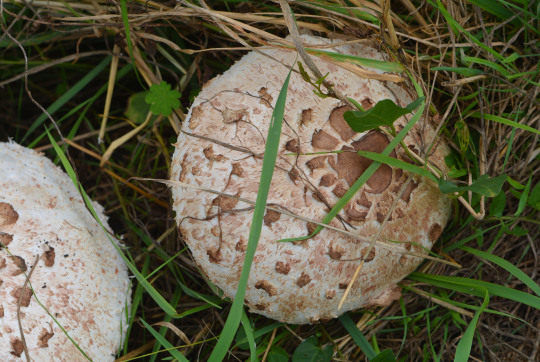

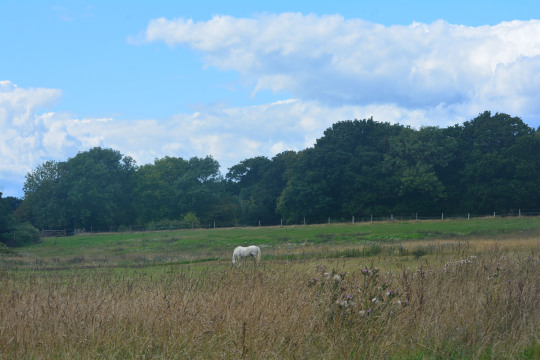
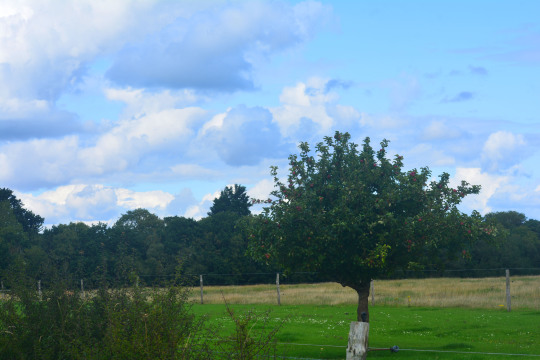



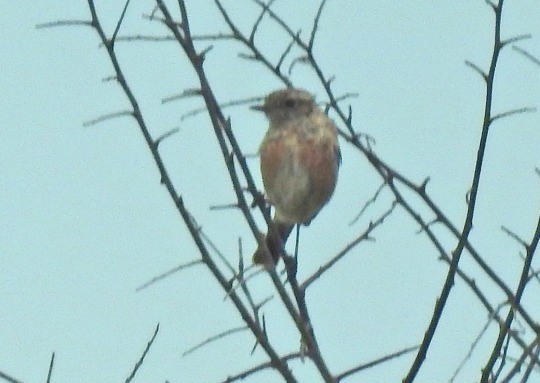
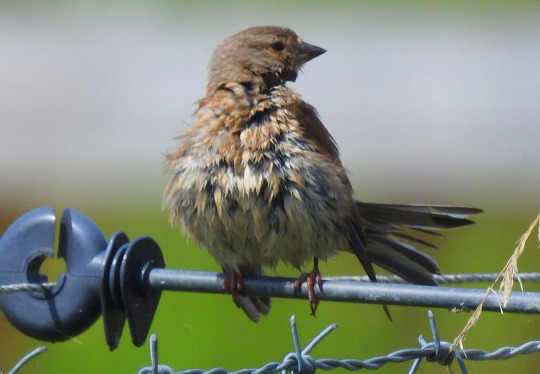

06/08/2023-Hook-with-Warsash
Photos taken here in this set are of: 1. Some massive mushrooms it was lovely to see. 2. One of the beautiful seas of chamomile it was a delight to see in the fields. 3, 4, 6 and 7. Nice field and sea views on a great walk round. 5. A Red Admiral I was fixated to see, fitting getting a photo of its star again on the final day of the Big Butterfly Count. 8. Stonechat. 9. Linnet, this rustic and plucky finch was a key bird seen on the walk seeing them in decent numbers. Watching them drink from puddles in gorgeous sunlight were lovely moments. 10. One of a couple of Roe Deers it was charming to see in the long grass of the fields, I always enjoy seeing these.
Hearing the shriek and seeing the beautiful large tern the Sandwich Tern as one flew by at the end was another bird highlight of the walk, with Common Tern seen hunting far out I believe, Cormorant and Lesser Black-backed Gull other coastal highlights. Buzzard, the quirky sight of Canada Geese in a field but we soon saw there was a pond we didn't know about beside them, Goldfinches, Song Thrush, Pied Wagtails, House Martin, Woodpigeons and a Rabbit were other good birds and mammals to see. My first ever Thick-legged hoverfly and a wealth of other butterflies including Holly Blue and Comma dancing along the lane, a nice Small Heath, Meadow Brown and Gatekeeper, Large and Small White and a Common Blue with a moth and other hoverflies Marmalade and possibly Hornet Mimic I believe seen were insect highlights. Pretty nightshade, ragwort, fleabane, lady's thumb aka redshank, yarrow, knapweed, bindweed, oxtongue, burdock, buttercup and bright cuckoo-pint berries were other key plants seen on the walk.
#cuckoo-pint#chamomile#nightshade#gatekeeper#red admiral#common blue#linnet#roe deer#linnets#sandwich tern#terns#cormorant#coast#hook-with-warsash#hampshire#uk#world#nature#happy#flowers#mammals#insects#butterflies#big butterfly count#birds#birdwatching#europe#2023
8 notes
·
View notes
Text
Art Studio 2 Additional Research: Chapter 4 of Bernie Krause and Roger Payne's book Wild Soundscapes: Discovering the Voice of the Natural World (20.9.24)
Notes:
Chapter 4, titled The Language of Soundscapes: New Words for Old Sounds, proposes a different approach to describing sounds of the natural world and discusses the overlap between soundscape ecology and art/music.
"Our spoken language contains few references to sound in the natural world." - The same thing applies to our musical and artistic (visual) language.
"Even our musical lexicon is replete with terms for sound based on the language of sight, such as colour, form, dark, or light."
Sound and sight are interconnected sensory experiences in art and in the natural world.
"Here’s a typical problem: crickets “chirp.” Well, so do birds. We need to find more precise words to help distinguish the sounds. For one thing, the sound-producing mechanism in birds, a syrinx, is different from that of a cricket scraping its wings together. ... In our descriptive language, however, a chirp— whether from bird, insect, or mammal— remains a chirp."
In short: Sounds of the natural world (and those made by people) are not created in the exact same way, having their own set of patterns, frequencies, volumes, etc.
The broad, comparative terms we often use describe a lot of these sounds ignore this complexity and diversity in soundscapes (in this case, 'chirping' for crickets and birds).
"From the latter half of the fifteenth century, a variety of musical expressions— most developed in Italy— became common in the language of classical composition. From time to time I fall back on these terms to describe elements of sound. The accompanying table lists examples of these musical terms, along with their original definitions as well as an example of how they have been extended to bioacoustic field work."
Music is not only inspired by sounds in nature, but the study of music can overlap with that of soundscape ecology.
Basically, musical terms such as 'accent', 'aeolian', 'drone', 'glissando', 'ostinato', 'polyrhythm' and 'timbre' can be used to describe sounds in the natural environment.
THEREFORE: The overlap between music and soundscape ecology mirrors the overlap between art and science.
"Maurice Merleau-Ponty, a French philosopher... wrote that language "is the very voice of the trees, the waves, and the forests."" - Both acoustic and visual language, that is.
"Olivier Messiaen, the mid-twentieth century avant-garde French composer, would note in some detail the birdsongs he found especially melodic, and incorporate variations into his compositions. ... While he attempted to represent some individual creature sounds, he never produced a full vocabulary or musical representation of either the birds he noted or the more complex biophonies he engaged with."
"How do you capture and replicate the roar of a lion, the stridulation of an ant, the complexities of the song of a Swainson’s thrush, a parrotfish, a long-horned sculpin (fish), or the sound signature of earthworms penetrating their soil- bound worlds? Likewise, the soundscape of a lake habitat with its mixture of insects, frogs, and loons, all at once with common musical notation or non- electronic orchestral instruments?"
This last question is something that I am attempting to explore in my own work but through a different lens: "Where and how do music (and by extension art as a whole) and the natural world overlap? And are there points where music, electronic or non-electronic, may 'mimic' these natural sounds, like how art can visually 'mimic' natural forms, colours and patterns?"
"When I ask people to describe their favourite natural sound, they invariably choose between two broad types: either marine or terrestrial. Using no particular words to describe them, they usually mention ocean waves, a stream, waterfalls, or rain, on one hand, or forests, birds in spring, deserts, or mountains on the other. The dynamic of natural soundscapes runs the gamut from the softest to the loudest sounds heard on the planet, and includes the lowest to highest frequency sounds in the realm of creature life. The power of this range contains a force that is infectious and, at the same time, subtle and animated."
In my own work, I've been looking into how the complexity of sounds can be translated into the 'visual/visible sphere'.
Reference (Chicago 17th)
Krause, Bernie., and Roger Payne. “The Language of Soundscapes: New Words for Old Sounds.” In Wild Soundscapes : Discovering the Voice of the Natural World, 55-68. Connecticut: Yale University Press, 2016.
#sca projects#year 3 art studio project 2#sca usyd new contemporaries grad show#aa sca yr 3 sem 2 week 8
1 note
·
View note
Text
Unveiling the Wonders of a Wildlife Safari in Malaysia
Malaysia, a Southeast Asian gem, is renowned for its breathtaking landscapes, rich biodiversity, and vibrant culture. Among the many adventures this tropical paradise offers, a wildlife safaris in Malaysia stands out as a must-experience activity for nature enthusiasts. Coupled with the thrill of jungle trekking in Malaysia, this journey through the heart of its lush rainforests and diverse ecosystems promises unforgettable encounters with some of the world's most fascinating wildlife. Here are five exceptional experiences you can expect on a wildlife safari in Malaysia.
1. Exploring Taman Negara National Park

Taman Negara, one of the world's oldest rainforests, is a prime destination for a wildlife safari in Malaysia. Spanning across three states—Pahang, Kelantan, and Terengganu—this national park boasts a staggering variety of flora and fauna. Jungle trekking in Malaysia finds its epitome here, with well-marked trails leading adventurers deep into the forest. As you trek, be prepared to spot Malayan tigers, Asian elephants, and a myriad of bird species. The park's canopy walkway, one of the longest in the world, offers a unique vantage point to observe the forest's upper layers and its inhabitants.
2. River Safaris in Kinabatangan

The Kinabatangan River in Sabah is another hotspot for wildlife enthusiasts. A river safari here provides a unique perspective on Malaysia's diverse wildlife. Gliding along the river, you'll encounter pygmy elephants, proboscis monkeys, and the elusive clouded leopard. The river's banks are teeming with life, from vibrant bird species to crocodiles basking in the sun. Night cruises reveal a different side of the jungle, with nocturnal creatures like owls, civets, and flying foxes making their appearance. This river safari not only showcases the region's biodiversity but also emphasizes the importance of conservation efforts.
3. Discovering Endangered Orangutans in Sepilok

No wildlife safari in Malaysia is complete without visiting the Sepilok Orangutan Rehabilitation Centre in Sabah. This sanctuary is dedicated to the conservation of the endangered Bornean orangutan. Visitors can observe these magnificent creatures in their natural habitat as they undergo rehabilitation to be reintroduced into the wild. The center's feeding platform offers a rare chance to witness orangutans swinging from tree to tree, displaying their remarkable agility and intelligence. The adjacent Sun Bear Conservation Centre provides an opportunity to learn about another threatened species—the Malayan sun bear.
4. Bird Watching in Fraser’s Hill

Fraser's Hill, located in Pahang, is a bird watcher's paradise. This hill station, surrounded by dense forests, is home to over 250 bird species. The annual International Bird Race attracts bird enthusiasts from around the world, highlighting the area's rich avian diversity. Jungle trekking in Malaysia takes on a more serene form here, with trails designed to offer the best bird-watching spots. From the strikingly beautiful silver-eared mesia to the rare Malaysian whistling thrush, Fraser's Hill provides ample opportunities to add unique species to your bird-watching list.
5. Night Safari at Kuala Lumpur's Zoo Negara

For those who prefer a more controlled environment, the Night Safari at Zoo Negara in Kuala Lumpur offers a glimpse into Malaysia's nocturnal wildlife. This guided tour allows visitors to see animals that are active after dark, such as leopards, tapirs, and various nocturnal birds. The zoo's open-concept enclosures mimic natural habitats, providing a safe yet realistic experience. This night safari is perfect for families and those who want to experience the thrill of wildlife observation without venturing deep into the jungle.
Conclusion
A wildlife safari in Malaysia, combined with the excitement of jungle trekking in Malaysia, offers an unparalleled adventure for nature lovers. From the ancient rainforests of Taman Negara to the serene bird-watching trails of Fraser's Hill, each destination provides a unique glimpse into the country's rich biodiversity. Whether you're cruising down the Kinabatangan River, observing orangutans in Sepilok, or enjoying a night safari in Kuala Lumpur, Malaysia's wildlife safaris promise unforgettable experiences that highlight the importance of preserving our natural world. So pack your bags, lace up your hiking boots, and embark on a journey to discover the wild wonders of Malaysia.
0 notes
Photo
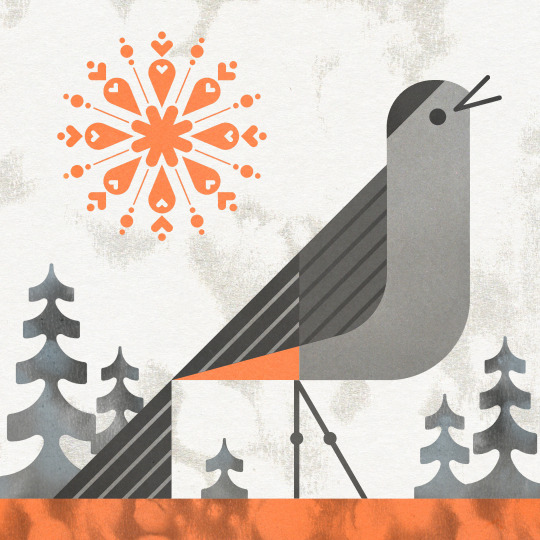
Grey Catbird
230 notes
·
View notes